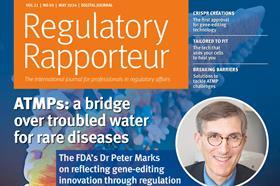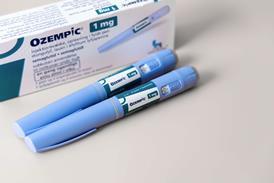
Regulatory Rapporteur
May 2024 | Volume 21 | No.5
Licence notice
Copyright © 2015-2024 The Organisation for Professionals in Regulatory Affairs Ltd. T/A Regulatory Rapporteur − All Rights Reserved. This work is licensed to Allison Gillespie for the purposes of academic and personal reasonable use only.
Notwithstanding this licence, no part of materials published in Regulatory Rapporteur may be reproduced without the express written permission of the publisher.
As a general rule, permission should be sought from the rights holder to reproduce any substantial part of a copyrighted work. This includes any text, illustrations, charts, tables, photographs, or other material from previously published sources.
To obtain permission(s) to re-use content published in Regulatory Rapporteur please email publications@topra.org.
To join TOPRA please click here.
Abstract
From 31 January 2025, clinical trials authorised under the old EU Clinical Trial Directive (CTD) must either have ended in the EU/EEA or have been transitioned to new EU Clinical Trial Regulation (CTR). Therefore, any ongoing trial with at least one active site in the EU beyond 30 January 2025 needs to be transitioned to the CTR before expiry of the transition period. The EU Clinical Trial Coordination Group (CTCG) has agreed on an expedited, harmonised member state (MS) evaluation procedure based on the validation of minimum application dossiers restricted to documents already authorised under the EU CTD.
This expedited procedure will be open until 16 October 2024 depending on the MS workload, and after that this procedure may not be available. There have been lots of recent updates in CTCG and Clinical Trials Coordination and Advisory Group (CTAG) transition guidance and EU transparency principles that directly impact the strategic and operational aspects of preparation, submission, and approval timelines of the transition applications. This article provides deep insights on a continuously changing regulatory landscape and the challenges associated with transition application.
Introduction

Following the implementation of the EU Clinical Trial Regulation (EU-CTR) on 31 January 2022, there was a designated three-year transition period during which time sponsors are required to submit a transition application in the Clinical Trial Information System (CTIS) portal for the trials running beyond 31 January 2025. However, the sponsors will still be able to submit substantial amendments under the old legislation until the expiry of this transition period. The clinical trials not authorised under EU-CTR, and still ongoing in EU/EEA at the end of the transitional period, will be considered as non-compliant with the CTR and sponsors may be subject to corrective measures by Member States pursuant to Article 77 of the CTR. For notification of global end of the trial (GEoT) and submission of trial summary results completed under the EU-CTD, the EudraCT platform will remain operational after the end of the transition period.[1]
The transition of clinical trials from Clinical Trial Directive (CTD) to the CTR is an administrative process, in which member state (MS) assessment is limited to ensure compliance with the new CTR rules (i.e. transparency and trial category). For multinational transition trial applications, the Clinical Trial Coordination Group (CTCG) has agreed on an expedited, harmonised MS evaluation procedure which is open until 16 October 2024 and involves submission of minimal Part-I/II application documents already approved under the CTD. The sponsors should register their clinical trials under the CTIS at their earliest convenience, taking account of statutory holidays and the two-week winter clock stop at the end of year. The basic principles to be followed for the EU-CTR transition application have been provided in Figure 1 below.[2],[3]
Figure 1: EU-CTR transition principles
It is also very important to note that for the addition of a new EU MS to a transitioned trial, a substantial modification (SM) application must be submitted and authorised before the additional MS application in which the Part I dossier must be aligned with the EU-CTR regulatory requirements.[2]
Important rules for the EU-CTR transition
Sponsors must consider the following important points and rules while planning and defining a regulatory strategy for the CTR transition of clinical trials approved under CTD.[1]
- Only interventional clinical trials in humans need to be transitioned.
- The clinical trial approved under the EU CTD must be transitioned if it involves at least one active site in the EU/EEA where the trial will be ongoing after 30 January 2025.(NB. Active site in the context of transition trials means that the last visit of the last subject, or other trial-specific interventions with the subject specified in the protocol will take place after 30 January 2025.)
- Clinical trials that have already ended or will end in EU/EEA MS before the end of transition period need not to be transitioned (i.e. end of trial notification has been submitted), even in the case where the global end of trial has not been reached yet. The GEoT notification and trial summary results can be posted via EudraCT under the CTD.
- There must be no pending regulatory authority (RA) or ethics committee (EC) assessments in any MS under the old CTD regime before submission of EU-CTR transition application.
- Clinical trials temporarily halted for safety or other reasons can be transitioned when foreseen to continue beyond the end of the transition period. These trials should immediately be notified by the sponsor as halted after transition.
Prerequisites for the EU CTIS transition application
In order to be prepared for submitting EU-CTR applications and notifications via CTIS, the following important steps and items must be completed by the sponsor, contract research organisations (CROs), trial sites and vendors involved in the clinical trial.[4]
EMA account
For access to the CTIS sponsor workspace, the sponsor will need to have a European Medicines Agency (EMA) account. It is very easy to create an EMA account by self-registration at the EMA account management page.[4]
Organisation management system (OMS) registration
The sponsor of a clinical trial must register themselves via a change request in the EMA’s Organisations Management System (OMS) Portal as the CTIS directly retrieves the organisational data from the OMS system. This step is mandatory for the sponsors to create the transitional trial application in CTIS. The registration process for a new organisation in OMS usually takes five-to-10 working days.
For the trial sites and any third parties, there is an alternative to record the organisation directly in the CTIS for study-specific submissions, however, prior registration in the OMS is recommended.[4]
High level administrator role in the CTIS
Under an organisation-centric approach, the sponsor’s responsible person will need to request a high-level administrator role using the EMA account. After assigning this high-level administrator role, the sponsor can delegate appropriate CTIS roles (e.g. CT-admin, Part-I/II Preparer etc.) within the company and to the other third parties (e.g. CROs) working on the regulatory applications. In case of a clinical-trial (CT) -centric approach, there is no sponsor administrator role so the CTIS user can directly create a new clinical trial application (CTA) and will automatically receive a CT administrator role for the specific clinical trial.[4]
Medicinal product registration in xEVMPD database
For completion of the medicinal products (test, comparator, auxiliary) related section of CTAs in the CTIS, it is mandatory that the details of medicinal products used in the clinical trial are already registered in the eXtended EudraVigilance Medicinal Product Dictionary (XEVMPD) database. The xEVMPD registered products will have EU Medicinal Product Number and EU substance number that can be used to automatically populate the product information in CTIS. It’s possible to add a placebo manually without pre-registration in XEVMPD.[1],[4]
Transparency requirements
The transition applications are also subject to EU CTR transparency rules and requirements. Therefore, the sponsor must prepare redacted versions of the protocol, subject information sheet(s) and informed consent form(s) (ICF) for the Category 2 and 3 trials (Phase II, III, IV clinical trials) in accordance with CTCG Guidance for the Transition of clinical trials 2. For Category 1 trials (Phase 0, and I clinical trials), the ICFs don’t require redaction as they will never be published.
At the time of submission of subsequent SM, the application dossier can then be updated with the documents for publication falling within the scope of the revised transparency rules, e.g. synopsis and recruitment arrangements.[2].[5]
Creation of a transitional trial in the CTIS Portal
The sponsor will need to create new initial CTA in CTIS and select the checkbox to indicate if a trial is a transitional trial. After creation of transitional trial, the structured data fields will appear in the application dossier and the user can add the old EudraCT number as well as the relevant Part-I/II documents in the CTIS.[1],[4]
Selection of reporting member state
If the initial submission of a clinical trial approved under the CTD includes more than one EU MS, the sponsor can propose one preferred MS to be the reporting member state (RMS). The RMS will be responsible for coordination of the oversight for the trial under CTR and issuing the common Part-I conclusion. In case the proposed RMS is unwilling to take on this role, the MS with the least workload will be assigned as RMS. The sponsor cannot influence this or appeal against this decision. For the clinical trials approved via the Voluntary Harmonisation Procedure (VHP), it is mandatory to indicate the Reference National Competent Authority (Ref-NCA) as the RMS [1],[2]
EU-CTR transition strategic considerations
As per the CTR transition rules, all the initial procedures and or ongoing amendments under the CTD must be approved prior to submission of the transition application. The crucial step is to evaluate if the same or different version of critical documents including the protocol, investigator’s brochure (IB) and/or investigational medicinal product dossier (IMPD) are approved under the CTD. This is required to have a harmonised or consolidated document for the transition to CTR. The transition of multiple versions of Part I documents (e.g. protocol, IB, IMPD etc.) within the CTR transition application under the single EU CT number is not allowed. Therefore, the sponsors can only upload single version of the respective consolidated document for each trial in the CTIS.[6]
- Harmonised document means that same version of a respective document is approved and includes the same trial procedures in all MS concerned under the CTD. The harmonised documents can be directly transitioned to the CTR.[6]
- A consolidated version of the protocol/IB/IMPD will be required for transition if there are substantial and/or non-substantial differences between respective documents approved in different EU MS. The MS-specific differences should be outlined within the document text or in an appendix. The consolidated version doesn’t need prior authorisation under the CTD before the transition.[6]
In case of a consolidated version of documents, the sponsors must declare in the cover letter that there are no substantial differences in content beyond the described discrepancies across MS compared to the latest versions approved in the respective MS under the CTD.
After approval of the initial transition application, the Part I and/or Part II dossier must be upgraded in line with Annex I of EU-CTR at the time of first SM application. Please note that if the labels of IMP and Auxiliary Medicinal Products (AxMP) are not in compliance with Annex VI of the EU-CTR, then the updated labels must be submitted with the first Part-I SM application. The released IMPs batches are not required to be re-labelled. The old label approved under the CTD can still be used after transition for the IMP/AxMP batches manufactured after transition until the new label is submitted and approved under SM Part I application.[2],[6]
Figure 2: EU-CTR regulatory strategic considerations
NIMPs, IMPs and Auxiliary Medicinal Products (AxMPs)
The non-IMPs (NIMPs) defined under CTD are termed as AxMPs under the new regulation. For clinical trials, in which the classification of IMP or NIMP differs between MS under the CTD, there are the following classification rules for the harmonisation of definitions under the CTR.[6]
- Current standard of care (SOC), or parts of it, will be considered as an IMP and not as background treatment if it is part of the trial hypothesis.
- This is the case if the primary or secondary trial objectives include investigation of interactions with the test product for complementary effects or possible adverse interactions or if the standard of care treatment is being used as a reference to compare the effect of the test product.
In these situations, the SOC is considered an IMP and not an AxMP. If a NIMP under the CTD is classified as an IMP under the CTR, the transition can take place without a prior substantial amendment under CTD. However, after approval of the transition application, with the next Part I SM application, the CTA should be completed with the correct definition.[6]
Documentation requirements for the transition application
The sponsor shall submit an initial transition application to the EU CTIS Portal which relies on the existing dossier already assessed and authorised by the MS under the CTD. The process will require a new cover letter and new application form (Part I and II) to be completed in the CTIS, and in case of multinational clinical trials, a harmonised or at least a consolidated version of the protocol/IB/IMPD. The minimum documentation required for the transition application is as follows.[2],[7]
- cover letter
- statement of compliance with regulation (EU) 2016/679
- proof of payment (if applicable)
- EU application form (to be completed in the CTIS portal)
- Part-I documents:
- clinical trial protocol (latest harmonised or consolidated version)
- IB (latest harmonised or consolidated version)
- GMP relevant documents (e.g. manufacturer’s importation autorisation (MIA) certificate, qualified person (QP) declaration)
- IMPD (latest harmonised or consolidated version)
- latest approved version of documents related to nIMPS (i.e. AxMPunder CTR), if applicable
- ·Part-II documents:
- Latest approved versions of the subject’s information sheet(s) and the ICF(s).
The CTCG has released a cover letter template for the transitional trials. The transition cover letter must contain EudraCT number, name of the ethics committee (EC) with date of initial clinical trial approval under the CTD and name of the NCA/EC that approved the latest versions of the trial documents.[2],[8]
The cover letter must include a sponsor’s declaration that the clinical trial is in line with the requirements for transition trials as set out in CTCG transition guidance and that the clinical trial is still in line with the authorisation given under the CTD. The sponsor is required to declare in the cover letter that all documents which need approval and are transitioned have been approved by the MS prior to the transition. [2],[8]
Table 1: EU-CTR annex-I regulatory documentation
| Part-I documents | Part-II documents |
|---|---|
|
|
In addition to minimum documents required for the transition, the sponsor may submit additional Part-I/II documentation (e.g. labels, insurances etc.) already assessed and authorised under the CTD. The MS may raise a validation/assessment consideration requiring the sponsor to submit additional Part II documents approved under the CTD.[2]
Except for the minimum transition dossier, the sponsor is allowed to submit a placeholder for the other Part-I/II documents required as per annex-I (Table 1) of the EU-CTR. The placeholder document uploaded in the CTIS portal must contain the following clarifying statement:
“This aspect was assessed by NCA and/or EC who has given a positive opinion on the clinical trial under the CTD (and therefore is covered by the conclusion of the assessment under the CTD)”.
However, these placeholders must be replaced with actual documents at the time of first SM (part I and/or part II) after approval of the transition application. There is no requirement to retrospectively create a site suitability form for the EU clinical sites approved under the CTD. If there is any new site submitted with the SM, then a suitability form is needed along with the other necessary documents required for this change.[2]
Timelines of approval for transition applications
Under the current CTCG expedited evaluation procedure, the maximum approval timeline for the transitional trial application based on the minimum Part-I/II dossiers approved under the CTD is estimated to be a maximum of 22 Calendar days (Figure 3)[2]
- validation phase without request for information (RFI) – 10 days
- assessment phase provided no RFI is needed – seven days
- part-I decision – five days
Figure 3: EU-CTR transition timelines
In case of validation RFIs, the timeline can be extended by 15 days. The assessment RFIs can also prolong the Part-I conclusion timelines.
The assessment of the Part II dossier is MS specific and usually leads to additional days before the final decision of authorisation per MS is issued for the transition application. As per the EMA document, ‘Key performance indicators (KPIs) to monitor the European clinical trials environment’ released in February 2024, the transition approval process can take up to three months.[9]
(NB. When the transition application is submitted, the CTIS system automatically generates a timetable with maximum statutory timelines [minimum= 60 days, in case of no RFIs and maximum = 106 days in case of validation/assessment RFIs] according to the CTIS rules for implementation of the Regulation[1],[2] However, the actual approval timelines can be even shorter than 60 days announced in the calendar.)
Obligations under the EU-CTR after transition trial authorisation
After transition authorisation, all the regulatory requirements of the CTR (refer list below) applies to the clinical trial from the date of approval in the CTIS.[2],[10]
- The sponsor will need to comply with the obligations of submission of notification (e.g. start of trial, start of recruitment) in the CTIS that could have occurred prior to authorisation under the CTD.
- Under the CTR, all suspected unexpected serious adverse reactions (SUSARs) must be reported in the EudraVigilance database, and the annual safety report (ASR) must be submitted in the CTIS. The serious breach will need to be reported through the CTIS within seven days of becoming aware of that breach.
- The EU transparency rules require sponsor to redact any personal data and commercially confidential information (if applicable) from the trial documents (e.g. protocol, ICF) that will be published through the CTIS.
- The sponsor and the investigator should archive the content of the clinical trial master file for at least 25 years after the end of the clinical trial unless other EU law requires archiving for a longer period. The medical files of subjects shall be archived in accordance with the national law of the MS.
- The sponsor will submit to the EU database CTIS a summary of the results of the clinical trial within one year from the end of a clinical trial in all MS concerned.
- The sponsor will need to follow the CTR rules for submission of first substantial modification and addition of a MS.
Recommendations for submission of transition application
Under the EU-CTR regulation, there are only 10 days to respond to the validation request for information (RFI) and 12 days to respond to assessment RFIs from RA/EC on the Part-I/II dossier. If the sponsor fails to submit the response in the CTIS within stipulated timelines, then the application will lapse. Based on Syneos’ experience with the transition trials, please find below recommendations to avoid potential RFIs during validation/assessment phases:
- Name of EC and date of approvals must be included in the cover letter.
- Include proof of payment (PoP) based on MS requirements.
- Latest versions of approved documents under the CTD to be submitted.
- Don’t include any new documents in the transition application because there will be no assessment of the application.
- It’s very important to propose trial category/deferral with transition application because this cannot be modified in subsequent Part I substantial modification applications.
- Some of the MS can raise consideration to including the name of a new EC responsible for assessment under the CTR.
- The sponsor should carefully assess the need to submit the relevant additional documentation (e.g. IB addendum approved under CTD) allowing the smooth assessment of the transition application.
- The country-specific documents should only be included in languages as approved under the CTD.
- Some of the MS have raised RFIs to submit CTD approved documents under relevant sections of Part II dossier in line with the EU-CTR.
- Some ECs requested to submit a list of the planned clinical trial sites, the name and position of the principal investigators and the planned number of subjects.
Conclusion
For the clinical trials that are expected to continue after 30 January 2025, the EMA has been encouraging the sponsors to submit the transition application as soon as possible considering the time needed for approval of the applications.[11] Therefore, the sponsors must assess the time required to obtain all pending approvals under the CTD, then develop a strategy for the preparation of a transition application as well as considering CTR approval timelines.
The sponsors should have trained regulatory resources to prepare and upload Part-I/II documents in CTIS and a robust process to manage RFIs (including redaction and translations) within very short timelines. Further, there should be advanced planning and assessments for the requirement to update the protocol and labels as per CTR rules as well as new Part-II documents that will need to be submitted at the time of first Part-I/II substantial modification.
Acknowledgements
The authors would like to acknowledge: Fabienne Lekaim, Director, Regulatory Consulting, Fatima Pimentel, Director, Regulatory Consulting and Reda Boumezber, Senior Regulatory Consultant, Regulatory Consulting, all of Syneos Health, for their assistance with this article.
References
[1] Clinical Trials Information System (CTIS) - sponsor Handbook. EMA/923413/2022 – v. 3.03, 6 November 2023. (Accessed 27 December 2023).
[2] Guidance for the Transition of clinical trials from the Clinical Trials Directive to the Clinical Trials Regulation. Version 3. March 2024. (Accessed 16 March 2024)
[3] CTIS newsflash – 10 November 2023. EMA/486111/2023.(Accessed 29 December 2023).
[4] Clinical Trials Regulation (EU) No 536/2014 in practice. version 05, March 2024.(Accessed 29 March 2024)
[5] EMA Q&A on the protection of Commercially Confidential Information and Personal Data while using CTIS, Question and Answers, version 1.4. EMA/898965/2022. 31 January 2024.(Accessed 16 March 2024)
[6] CTCG Best Practice Guide for sponsors of multinational clinical trials with different Part I document versions approved in different Member States under the Directive 2001/20/EC that will transition to the Regulation (EU) No. 536/2014. Vs 4.0, 07 March 2024. (Accessed 16 March 2024).
[7] Clinical trials regulation (EU) No 536/2014, Questions & answers, Version 6.8. March 2024.(Accessed 16 March 2024)
[8] CTCG key documents list, Guidance, Transitional Trials.(Accessed 05 January 2024).
[9] Monitoring the European clinical trials environment- A deliverable of the ACT EU Priority Action 2. January 2024 (Accessed 16 March 2024)
[10] Regulation (EU) No 536/2014 of the European parliament and of the council of 16 April 2014 on clinical trials on medicinal products for human use, and repealing Directive 2001/20/EC. 27.5.2014.(Accessed 05 January 2024)
[11] EMA (2024) Clinical trials’ transition to new EU system - one year left. (Accessed 01 February 2024)
Topics
- Clinical Trial Coordination Group (CTCG)
- Clinical Trial Directive (CTD)
- Clinical Trial Information System (CTIS)
- Clinical Trial Regulation (CTR)
- Clinical Trials Coordination and Advisory Group (CTAG)
- European Economic Area (EEA)
- European Medicines Agency (EMA)
- European Union (EU)
- Member State (MS)
- RR-2023
- RR-Reprint-Licence































